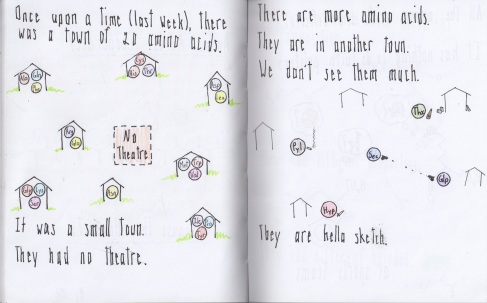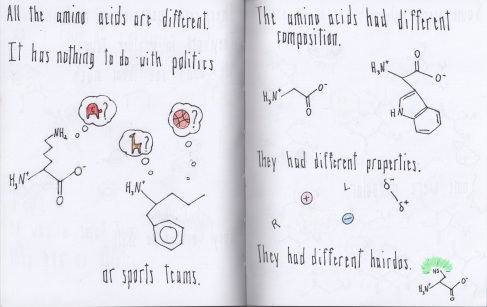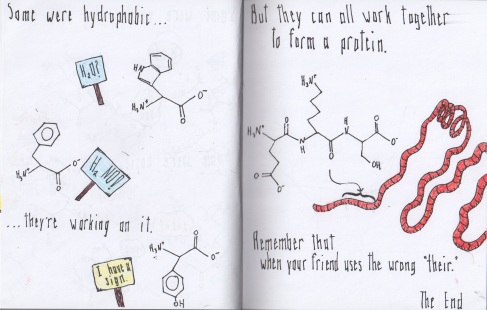As promised, I bring you the second biochemistry “children’s” book. I will also be replacing the crappy images of Little Poly.
Monthly Archives: September 2013
All Aflutter
Wow, Little Poly was a LOT more popular than I expected. You know what that means?
Y’all are NERDS.
Also I might have another story.
Also I might start doing these in other topics. On an actual scanner.
Shit is getting REAL here, guys.
Story Time: Little Poly and the Anarchist’s Dilemma
Story Time: The Little Protein That Could
Story Time, kiddies! Gather round and I shall tell you a tale of The Little Protein That Could (and Would, Whether you Liked It Or Not).
Once upon a time there was a little protein. It was brand new and only 200 amino acids long. Which I suppose isn’t so little, polypeptide chains can be between 50 and 2000 amino acids long, but it’s certainly small compared to a lot of things., like a tissue or an organ or a schnauzer. Anyway, this was a denatured little protein, just a randomly coiled string of amino acids with only a primary structure to call its own. No secondary or tertiary, let alone quartenary structure! But it dreamed of folding into a functional protein, of finding its native state. Its friends had started out the same way, unfolded and unfunctional, but they had folded and moved on in the world. The little protein could not expect help from them. It couldn’t just try all the conformations available; that would take too long (to the tune of many thousands of years). So the little protein had to find help.
There were scientists studying all the proteins, but they were too distracted by the unpredictable coils of the denatured little protein (they understand very little of such things). Also proteins aren’t sentient and can’t talk. So the little protein had to rely on its self. Looking deep within (its primary structure), the little protein realized it had all the information it needed to folded within its primary structure! Insofar as proteins realize things (which is to say that they don’t). The very amino acids composing it could interact with one another via hydrogen bonds, disulfide bonds and other electrostatic interactions to find its energetically favorable native state.
Once folded, the little protein felt (“felt”) such relief (“relief”); the native state was a lower energy state than when it was unfolded. Now after its long (“long”, a fraction of a second) journey, it could go out into the world and follow its destiny (biological function).
The End.
Moral of the story: Look inside yourself and let your amino acids guide you.
Source
Sholders, Aaron. “Thermodynamics.” Biochemistry. Colorado State University. Fort Collins, CO. Jan 2013. Lecture
Protein Bangles
Get used to seeing lots of biochemistry in the coming months because guess what class I am taking! Ten points if you said biochemistry, twenty consolation points if you said Intermediate Snare Craft. To start with, y’all need some of the basic facts on protein. And I don’t mean that it’s one of the basic food groups.
First thing’s first: proteins are made up of amino acids, which in turn are composed of codons. I can only define all these things in a very round way, so bear with me. Remember the base pairs of DNA? They connect to two helices and are abbreviated with A, T, C and G. Identical base pairs are found in RNA (With the exception of T being replaced by U), which is like the paternal twin of DNA; they look very similar but are in fact very distinct. RNA provides the instructions for translation, literally the translation of genetic instructions into (hopefully) functioning proteins. Three bases make up a codon, which, depending on the codon, indicate particular amino acids for the translation proteins to assemble into the protein. Because I don’t want to take an even bigger detour, think of RNA as beading instructions. The codons represent an amino acid bead that needs to added to a string until you have the whole bracelet, or whatever.
Now the analogy gets a little funky. Proteins are made up of a combination of twenty beads (nine of which we can’t manufacture and need to consume, hence the nine essential amino acids) which start out as a string (or a peptide chain), but do not stay that way. The strand of beads is only the primary structure. Depending on the composition of the protein, the strand may fold into an alpha helix or a beta pleated sheet. Those are examples of secondary structure. The protein can then fold further into a tertiary structure, and then bind with other, separate strand in an oligomer (protein made of multiple subunit proteins). This oligomer is its quartenary structure. Consider an elaborate beaded necklace, like…this one:
We have two main strands of beads, with differently shaped groups attached. Now, some necklaces may need fewer separate strands and some need more, just as with proteins. An entire functioning protein may be fibrous and composed of many strands (silk, keratin, collagen, etc) and then it really looks like a necklace. But then there are proteins that are more like the beaded lizards you made in grade school. Bits and bobs EVERYWHERE. Make one out of beaded wire and smoosh it and then you have a globular protein. They’re kind of a mess, but they’re a necessary mess. Think enzymes and hemoglobin.
Homework for tonight: make beaded lizards and/or protein.
Send pictures.
Sources
Jackson, Mark. 2009. “Biochemistry Chemical Concepts.” Quick Study Academic Outlines. BarCharts Inc.
Photo credit, Swift’s Jewelry: http://swiftsjewelry.com/swifts_panamshoot23/










